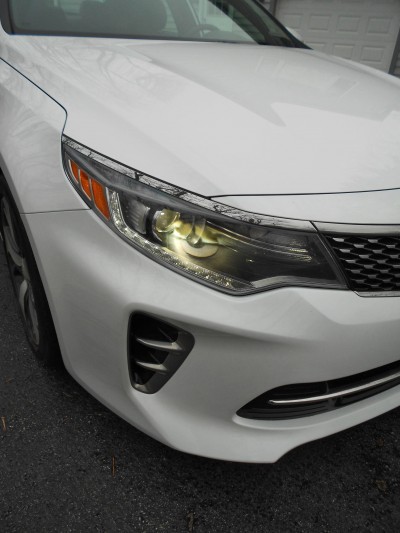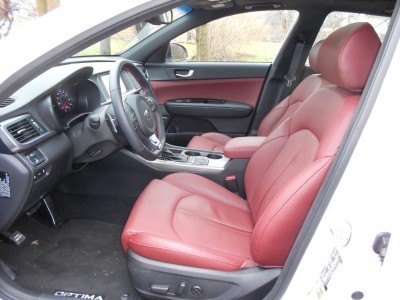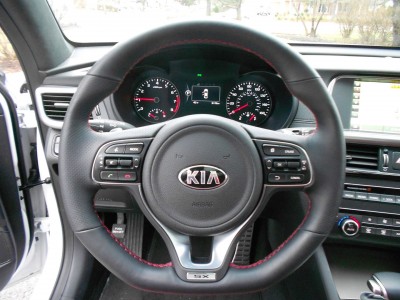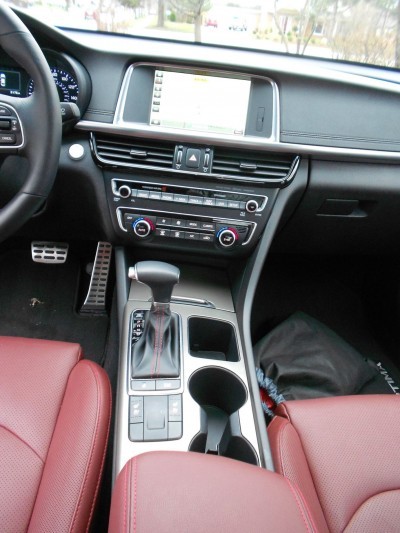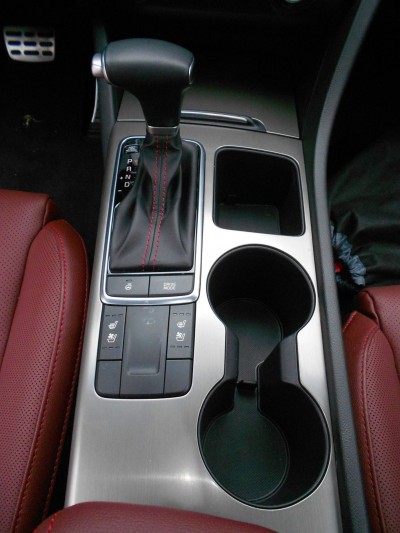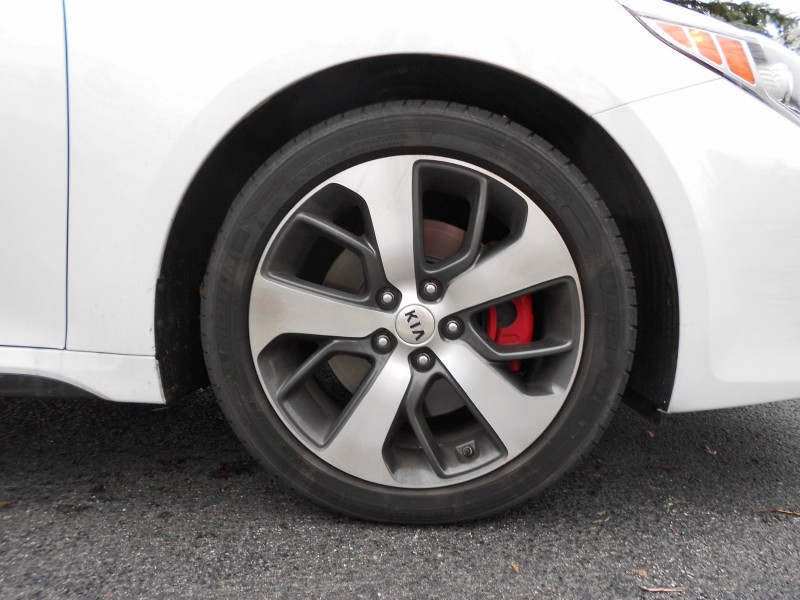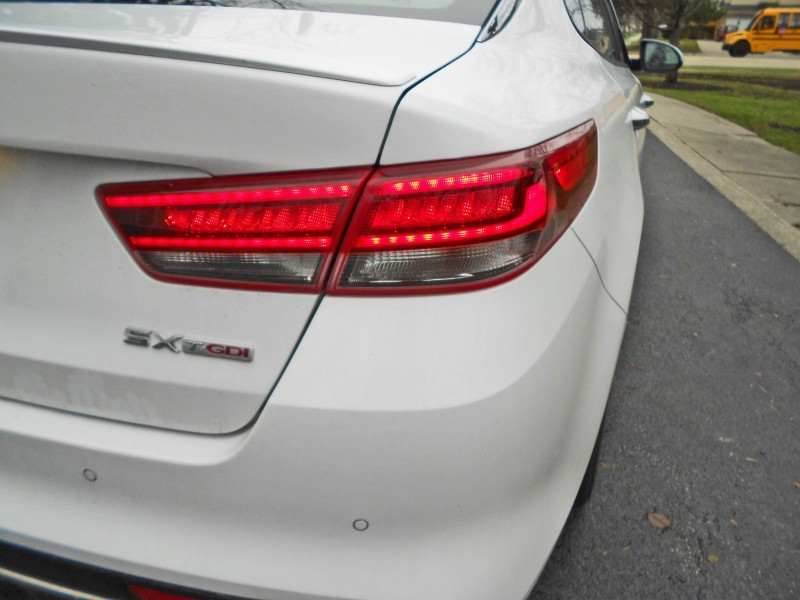2016 Kia Optima SX Turbo Review
By Ken “Hawkeye” Glassman
Midsize family sedans are a huge segment of the automobile business, and it’s a hotly contested space. The Kia Optima is a strong player, and getting stronger each year, with improvements and even more standard content. It has to keep improving in order to compete with the likes of a Toyota Camry & Avalon, Honda Accord, Ford Fusion, Mazda 6, or Nissan’s Altima.
The 2016 Optima has been redesigned inside and out, and the result is an outstanding automobile, that ranks right up there with the best in the class.
Our test car, the SX Turbo, comes with a 2.0 liter turbocharged and intercooled 16-valve inline-4 engine, with aluminum block and head, and direct fuel injection. And it’s a honey of an engine, which puts out 245hp and a very hearty 260 ft. lbs. of torque at a low 1350 rpm. Those numbers are down a bit from last year’s model, BUT, the torque comes on at a lower rpm, which is where you’d like the torque to be, and it stays in a wider range for a better driving experience. The retuning also makes the engine much quieter and more composed, which is a good trade-off. And still, you’ll go from zero to 60 in under 7 seconds, which is excellent compared to the other cars in this segment. EPA fuel Economy numbers are 22 City and 32 Highway. Those figures are a little lower than a Camry, but a bit higher than an Avalon. And all three of those cars are very close in size dimensions.
The power goes to the front wheels through a 6-speed manumatic that shifts quickly and smoothly in both full automatic mode, or if you choose to change the gears manually. And you can push a button for Economy or Sport mode depending upon how frisky you’re feeling that day.
Kia didn’t neglect the chassis in this redesign. It feels stiffer and more composed due to the addition of high-strength steel and adhesives, and the SX and SXL models gets the electric power steering motor mounted directly to the rack, (instead of column mounted in the other trim levels) which aids in steering response and predictable feedback. Cornering loads don’t make the car lean as much, and the flat cornering gives the driver the confidence to use all the grip to enjoy challenging roads. The suspension handles rough pavement and pot holes well, and makes the whole ride quality feel refined and well sorted.
The ABS brakes also felt predictable and strong in hauling the 3,584 lb. car down from speed. The pedal feel is also improved from the previous model.
I found the ride quality on the highway to be very comfortable. It was a smooth boulevard ride, yet without any wallowing over large dips. Rebound damping was excellent. I spent most of the time in Sport mode, and on some twisting roads, and found the Optima to be fun and rewarding. No, it’s not designed to be a sports sedan, but you can toss it into a tight turn, and accelerate through the apex with a bit of tire squeal, and be confident that nothing untoward will upset the chassis.
The cabin of this Optima is strictly luxury-grade, and would make anyone think they were in a car costing thousands more. It’s a quiet place, with plenty of leg and head room and comfort for 5 adults.
The redesigned dashboard is pleasantly shaped, and divided by some real metal trim into an upper and lower portion. The large touch screen Nav system dominates the upper portion while there are easy to see and operate controls for the HVAC, and push button controls to work the various media, phone, settings, etc. Below those, is a handy covered storage space for phone or music device and the 12-volt outlet, USB port, and AUX input.
The Merlot colored, rich looking and feeling power adjustable heated and cooled leather seats were all-day comfortable. They also feature a power lumbar support that not only inflated, but could be adjusted vertically to place it exactly where the driver needs it. That’s a nicety not found in cars in this price range. The door panels have the same color trim as the seats for a rich look. Soft touch materials on the door armrests and sills, and center console, are appreciated.
Rear seat passengers will be quite comfortable. Plenty of leg room to stretch out, and headroom is also good. Even a middle seat passenger will still be more comfortable than in the middle seat of an airplane. The trunk has 16 cubic feet of cargo space and a wide and low lift height makes it easy to access.
Kia and its sister company Hyundai have grown up in the US with the reputation of offering a lot of content in their cars, giving them high marks on the value quotient. This Optima is no exception. Standard items are 18”wheels, a full array of airbags, Dual Zone Climate Control, tilt and telescope steering wheel, navigation system with 8” screen and rear camera, all necessary input jacks and outlets, rear center console with USB chargers and 12-volt outlet. It is Bluetooth ready, and has a power driver’s seat with lumbar, memory seats with memory outside mirrors, heated leather seats, Smart Key with push button start, thick leather wrapped steering wheel, with paddle shifters, redundant steering wheel controls, auto dimming rear view mirror, HID auto-leveling headlights, power folding heated outside mirrors, LED taillights, and dual chrome exhaust tips.
The car equipped just like this would cost $29,690, and would be an excellent value, compared to the competition. Our test car, added the SXT Launch Edition Package, which includes upgraded alloy wheels, the Panoramic Moonroof, Harman Kardon premium sound system, the Merlot colored leather seats and trim, power front passenger seat with lumbar, heated and cooled leather front seats, heated rear seats, Blind Spot Detection, Rear Cross Traffic Detection, Rear Parking Assist, and LED overhead lighting. All of those features in the package cost only $2,700. There is a lot of value in that option package. A package like that on a Lexus or BMW would cost double.
The bottom line on this Optima came to $33,215, which buys an outstanding, well equipped family sedan. In fact, as much as I liked the 2016 Toyota Avalon I had for a week, this Optima would be my choice between the two, and it has more content than the Avalon, and is $4,000 less.
And if you wanted to go full on loaded, you can add the $4800 Premium Technology package. That buys you adaptive cruise control, front-collision warning, an electronic parking brake, lane-departure warning, and autonomous emergency braking. Those are all excellent additional safety features, and if so equipped, the Optima would still be price competitive with anything the competition can throw at it, and still feel like a more expensive car.
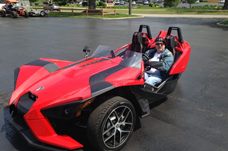
Ken “Hawkeye” Glassman has been a motor journalist for over 30 years, reviewing automobile, as well as motorcycle ride reviews and accessory reviews.
His car articles have appeared in Robb Report Magazine, Autoguide.com, Car-Revs-Daily.com and other media. His work has also appeared in Road Bike Magazine, Motorcycle Tour and Cruiser, SpeedTV.com, MotorcycleUSA.com and others.
As motorcycle columnist for The Daily Herald in suburban Chicago, the paper became the only major circulation newspaper in the country to have a separate weekly section devoted to motorcycles. Later he wrote a weekly column for Cyclefocus Magazine.

